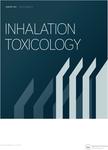版权所有:内蒙古大学图书馆 技术提供:维普资讯• 智图
内蒙古自治区呼和浩特市赛罕区大学西街235号 邮编: 010021

作者机构:Bayer Corp Div Agr Stilwell KS USA Bayer Corp Div Agr Shawnee KS USA Bayer Corp Div Agr Kansas City KS USA
出 版 物:《INHALATION TOXICOLOGY》 (吸入毒理学)
年 卷 期:2000年第12卷第7期
页 面:605-615页
核心收录:
学科分类:1007[医学-药学(可授医学、理学学位)] 1001[医学-基础医学(可授医学、理学学位)] 10[医学]
基 金:International Isocynates Institute Inc. (AM-AB-89 AM-AB-89-II)
主 题:投药 吸入 气雾剂 过敏反应/病因学 体重/药物作用 药物过敏/病因学 药物过敏/病理生理学 半抗原/投药和剂量 半抗原/免疫学 吸入暴露 体积描记术 全身 呼吸/药物作用 呼吸超敏反应/化学诱导 呼吸超敏反应/病理生理学 血清白蛋白/免疫学 动物 豚鼠 男(雄)性
摘 要:The potential exposure of workers to both 2,4-toluene diisocyanate (2,4-TDI) and 2,6-TDI led to an investigation of the comparative respiratory sensitization potential of these two isomer. Separate groups of guinea pigs were either sham exposed or exposed to one of the isomers 3 h/day for 5 consecutive days (sensitization phase). The mean concentration during the sensitization phase ranged from 1.29 to 1.40 ppm. The animals were then conventionally housed for 2 wk and challenged for 1 h on 3 subsequent weeks with either the same isomer or the alternate isomer. The first 2 wk of the challenge phase involved exposure to TDI vapor (18 to 46 ppb), whereas the third challenge was to an aerosol of TDI-guinea pig serum albumin (GPSA) conjugate (18 to 32 mg/m(3)). The endpoint used to detect both immediate-onset and delayed-onset hypersensitivity responses was respiratory rare. Body weights and clinical signs were also recorded. There were clear decrements in iz eight gain in response to the wk I exposure to either isomer of TDI. bur no isomer-specific differences were observed. Clinical signs revealed irritation to the respiratory tract only during the sensitization phase. A single animal challenged with TDI-GPSA may have experienced a severe anaphylactic response during the challenge phase. The incidence of immediate-onset hypersensitivity responses resulting from challenge with TDI vapor was less robust and less consistent than that resulting from challenge with the TDI-GPSA conjugate. All groups sensitized with either isomer showed an increased incidence of responders. Tl,ere was no apparent difference between the two isomers. The delayed-onset phase produced more spontaneous variability in spontaneous respiratory rates and was not amenable to analysis for response to TDI challenge. Thus, no isomer dependent differences were observed.